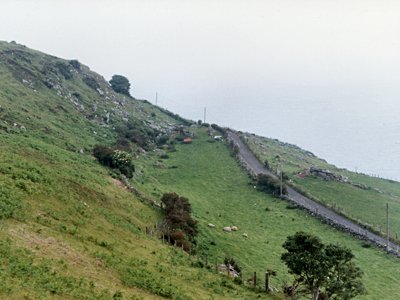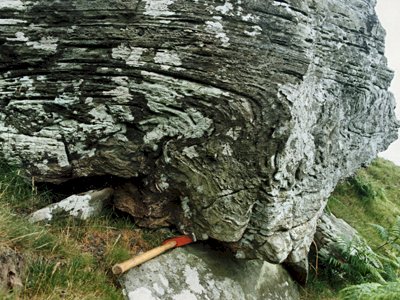Earth Science Conservation Review
| Carnaneigh - Dalradian | Antrim |
| Site Type: | Crag, Crags |
| Site Status: | ESCR |
| Grid Reference: | D256365 |
| Google maps: | 55.16015,-6.02937 |
| Rocks | |
|---|---|
| Rock Age: | Precambrian (Dalradian) |
| Rock Name: | Carnaneigh Green Beds, Runabay Head Formation, Southern Highlands Group |
| Rock Type: | Schist |
| Interest | |
| Minerals: | Chlorite, Epidote |
Summary of site:
This site gives its name to one of the subdivisions of the ancient and complex series of Dalradian rocks in Northern Ireland.
The Dalradians form two major groups: the Argyll Group below and the Southern Highland Group above. In north-east Antrim the Southern Highland Group is further divided into three formations: the Altmore Formation at the base, the Runabay Formation in the middle and the Glendun Formation on top. The rocks at this locality form the Carnaneigh Green Bed Member, a subdivision of the Runabay Formation, and define its base. In appearance they are pale grey and green schists containing quartz (grey, hard grains), chlorite (giving the green colour) and biotite (a black mica giving the characteristic schist sheen).
Although the Dalradians are regionally metamorphosed (highly altered) rocks, it is possible to work out their original state and geography. Shortly after the supercontinent of Laurentia split from Gondwana, around 600 million years ago, its margin buckled into a series of submarine downwarps, creating huge basins in which sediments streaming off the land gathered. The sediments on the continental slopes, including sand, mud, volcanic ash and dust, became unstable and slid into deeper water, mixing in the process (creating turbidites), before settling. The metamorphism of these beds followed over 100 million years later, during the Grampian orogeny, by which time they were deeply buried. This subjected them to temperatures between 300 and 500ºC (low in metamorphic terms) and high pressures. In this environment the new minerals already mentioned were formed; particularly significant is chlorite, the green mineral in the member's name, which betrays its volcanic content.
The metamorphism also deformed the rocks and a variety of small scale folds can be seen at Carnaneigh, suggesting at least two phases of activity. This entire coastal outcrop is part of a gigantic regional fold and the rocks at this locality are upside down - part of the inverted limb of the immense Altmore anticline.
This site is of international importance and allows direct comparison with the Southern Highland Group in its source area in Scotland. The Carnaneigh Green Bed Member forms a distinctive marker band in this area of complex geology and its mapping clarifies the succession and structure of the rocks. A stratotype for the member (the best sequence for comparison) should be defined in this area.
Exposure is good in this hill pasture country and there are no threats of consequence.
The Dalradians form two major groups: the Argyll Group below and the Southern Highland Group above. In north-east Antrim the Southern Highland Group is further divided into three formations: the Altmore Formation at the base, the Runabay Formation in the middle and the Glendun Formation on top. The rocks at this locality form the Carnaneigh Green Bed Member, a subdivision of the Runabay Formation, and define its base. In appearance they are pale grey and green schists containing quartz (grey, hard grains), chlorite (giving the green colour) and biotite (a black mica giving the characteristic schist sheen).
Although the Dalradians are regionally metamorphosed (highly altered) rocks, it is possible to work out their original state and geography. Shortly after the supercontinent of Laurentia split from Gondwana, around 600 million years ago, its margin buckled into a series of submarine downwarps, creating huge basins in which sediments streaming off the land gathered. The sediments on the continental slopes, including sand, mud, volcanic ash and dust, became unstable and slid into deeper water, mixing in the process (creating turbidites), before settling. The metamorphism of these beds followed over 100 million years later, during the Grampian orogeny, by which time they were deeply buried. This subjected them to temperatures between 300 and 500ºC (low in metamorphic terms) and high pressures. In this environment the new minerals already mentioned were formed; particularly significant is chlorite, the green mineral in the member's name, which betrays its volcanic content.
The metamorphism also deformed the rocks and a variety of small scale folds can be seen at Carnaneigh, suggesting at least two phases of activity. This entire coastal outcrop is part of a gigantic regional fold and the rocks at this locality are upside down - part of the inverted limb of the immense Altmore anticline.
This site is of international importance and allows direct comparison with the Southern Highland Group in its source area in Scotland. The Carnaneigh Green Bed Member forms a distinctive marker band in this area of complex geology and its mapping clarifies the succession and structure of the rocks. A stratotype for the member (the best sequence for comparison) should be defined in this area.
Exposure is good in this hill pasture country and there are no threats of consequence.
| Enlander, I., Dempster, M. & Doughty, P., 2025. Carnaneigh - Dalradian, County Antrim, site summary. [In] Earth Science Conservation Review. https://www.habitas.org.uk/escr/summary.php?item=160. Accessed on 2025-04-03 |
| Previous Site | Next Site |

